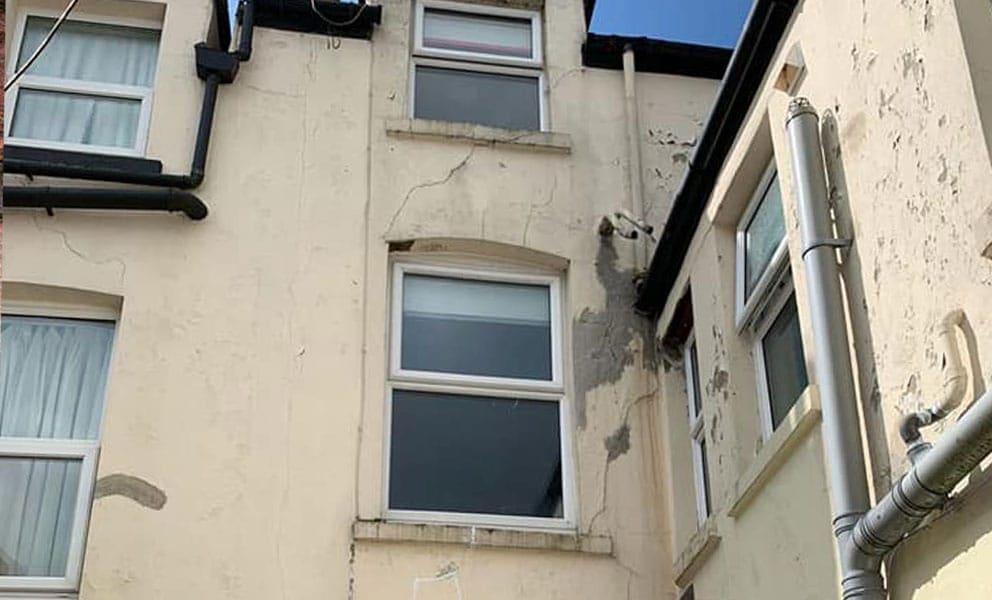
In this post, we’ll take a closer look at the different types of cracks, what causes them, and how to repair cracks on exterior walls.
One of the most common types of cracks in exterior walls are those in the render. These can occur if the render dries too quickly. But more often than not, they happen because of natural expansion and contraction from the changing temperature and weather conditions around them.
Another type of crack you might find are those in the brickwork. If you live in an older building, these are relatively normal. Again, it’s down to expansion and contraction over time because of changing humidity levels and temperatures.
In this case, the cracks will typically be smaller than 15mm, depending on how long they’ve been left to develop. They can still be repaired by repointing, although some brickwork may need to be replaced.
One of the most typical causes of exterior wall cracks is foundation settlement. When the ground beneath the foundation shifts or settles, it can put stress on the external walls, resulting in cracks.
Water infiltration is a major cause of exterior wall cracks. Rainwater, melting snow or plumbing leaks can seep into the walls, causing material erosion and structural weakness. This is especially common in places with poor drainage or insufficient sealing.
Excessive weight or strain on the outside walls, such as from heavy machinery, badly fitted fixtures or building extensions, can cause stress and cracks.
Failure to perform routine maintenance, such as repointing mortar joints, sealing cracks or resolving minor concerns on time, can cause smaller cracks to worsen over time.
To properly repair exterior wall cracks, it is essential to determine the source. You might have to consult with a structural engineer or a skilled contractor to assess the severity of the problem and decide on the right repair or preventative steps.
If your exterior wall cracks are more than 15mm in width, you’ll probably need to undertake some more substantial repairs. These larger cracks go hand in hand with sloping floors, leaning walls and the disruption of windows and door frames. As a result, you might need to replace entire sections of your walls.
If cracks are even bigger, moving towards or above the 25mm mark, you may be dealing with subsidence. This is when the ground underneath your house collapses or sinks, disrupting the foundation and putting more strain on some parts of the building. In this case, a major repair job will usually be required to put things right.
To help recognise exterior cracks that are beyond a DIY fix, the Building Research Establishment (BRE) uses a size classification system:
Level 0: Hairline cracks (<0.1mm) - No outside wall repair needed.
Level 1: Fine cracks (up to 1mm) - Cracks rarely visible externally.
Level 2: Crack width up to 5mm - Easily filled; may require some repointing.
Level 3: Cracks (5mm – 15mm) - May need opening up and patching by a mason. Often involves repointing and possible brickwork replacement.
Level 4: Major damage; cracks (15mm – 25mm) - Sections of outside wall may need replacement, not just repair.
Level 5: Serious structural damage; cracks 25mm+ - Major outside wall repair, including possible partial or complete rebuilding.
While large cracks in your brickwork require structural repairs, there are some easier ways to deal with smaller cracks in your render:
One solution is to re-render the wall entirely, although this is understandably expensive and time consuming – and there’s no guarantee that the new render won’t crack.
Alternatively, you can try render crack fillers. These come in various forms like silicone render, repair mortar and masonry filler, but they’re not particularly effective or discreet. If you decide to go for this option, there are a few steps to follow to ensure you get the best results:
Note the size and type of crack, looking for structural issues.
Remove loose debris and dust to clean the area and create a strong foundation before you apply your chosen filler.
Use specialised brick sealant or mortar repair caulk to fill hairline gaps. Remember to follow the manufacturer's recommendations if using a caulking gun. For larger cracks, you can use a trowel to apply the cement filler or plaster mix onto the exterior wall.
The final option is to renew your existing render with SprayCork, a cork-based coating. This combines the best of both worlds, with a smooth uniform appearance and no need to remove the existing render. Plus, it’s long lasting, with natural flexibility and water resistance from the cork.
If you’ve noticed small cracks in your exterior rendered walls, it’s always better to tackle the issue head on rather than letting it fester. Without an effective recoat, cracks will only get worse, and eventually, you’ll have no choice but to remove the render altogether.
CorkSol can help you avoid this hassle with a professional cracked render repair service from one of our fully trained applicators. With manufacturer training and our cork-based spray, they are fully equipped to make your exterior wall cracks disappear.
Ready to put SprayCork to the test? Get a quote from one of our approved applicators today.
"*" indicates required fields